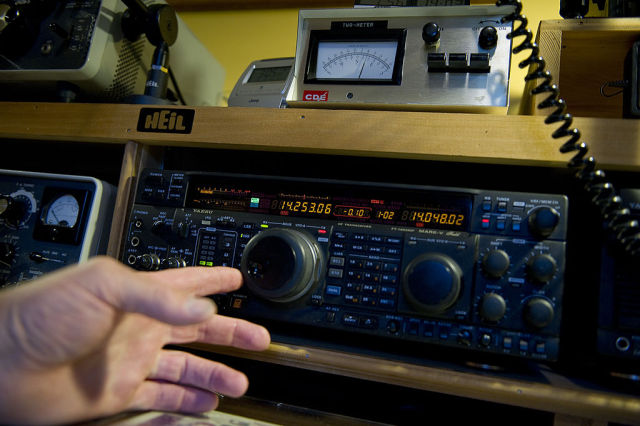When everything else fails, amateur radio will still be there—and thriving | Ars Technica UK

Getty Images
It’s a good time to be technical. Maker communities are thriving around the world, tools and materials to create and adapt are cheaper and more powerful now than ever, and open source hardware, software, and information mean that if you can think it, you can learn how to do it and then make it happen.
For one group of technological explorers, this is more than just a golden age of opportunity: it’s providing the means to save one of the oldest traditions in electronic invention and self-education, one that helped shape the modern world: amateur radio. That matters.
Further Reading
Radio amateurs get a sweet deal, with effectively free access to many gigahertz of the same radio spectrum that companies pay billions for. They’ve earned it. Throughout the history of electronics, they’ve been at the borders of the possible, trying out ideas that commerce or government deem impossible or pointless—and making them work. One example of hundreds: Allied military comms in World War II needed a way to reliably control the radios used by front-line forces, replacing tuning knobs with channel switches. Hams had the answer ready and waiting: quartz crystal oscillators. (That's part of computing history too—you’re probably using about ten of them right now.).
The trouble with making a success of frontier territory is that it doesn’t stay frontier for long. As radio hams colonised new frequencies and new methods, government and commercial interests wanted in—and got it. What was useless yesterday can be very desirable today, and a lot of the ham bands in the once-fallow UHF and microwave spectrum now look very tempting for wireless data, satellite downlinks, and the constant chatter of the Internet of Things. Some attacks on amateur spectrum have been repelled, others have succeeded. More are on the way.
It has looked a losing battle at times, as the relevance of amateur radio seemingly faded with the advent of the Internet and cheap digital technology to play with. Radio hams looked like yesterday’s people, as relevant as steam engine enthusiasts in the age of spaceflight. Who cares if they lose their spectrum if the rest of us can stream more HD cat videos as a result?
There’s enough truth in that to make it dangerous: a large cohort of hams just want to play with radios and talk to their pals—but it masks four things that amateur radio still does that can’t be easily replaced.
Tim Peake aboard the International Space Station, describing how he communicates with on-Earth schools via ham radio.
Start with STEM. In the days of valve radios, it was a standard rite of passage for ten year olds to take them apart and find out how they worked: Richard Feynman, Claude Shannon, and Robert Noyce all started that way. Good luck taking the back off an iPhone, kids—but the whole path from simple radio receivers to megabit interplanetary communication is still there. Amateur radio will take you every step, bypassing barriers and making connections. There’s a reason ham radio is aboard the International Space Station.
Then, there’s backup. Take the European HAMNET, for example. That’s a four-thousand-node high speed data network covering a large part of continental Europe and providing full IP connectivity at megabit speeds. It connects to the Internet—ham radio owns 16 million IPV4 addresses, believe it or not—but is independent of it, doing its own robust and flexible routing. If the Internet was to go away, HAMNET would still be running. The same’s true of nearly all ham radio infrastructure: when everything else fails—power, comms, roads—ham radio is still there, and these days it can be a full-fat digital medium.
This independence gives ham radio a further edge. It is vigorously non-commercial and non-governmental, and by law has to be open—encryption is almost completely forbidden. It’s open to all nations (and nearly all allow it). It has survived war, dictatorships, disaster and CB radio. If you want to use the airwaves, then provided you can pass a simple technical test and pay a nominal admin fee, you don’t need any further permission. Increasingly, that means unique creations that can’t happen any other way, like global free-to-access digital voice radio networks and international automated satellite tracking and data systems.
Further Reading
This resurgence has helped amateur radio keep its place at the negotiating table with regulators and lawmakers. It’s kept the world full of active expertise in wireless, one of the major drivers of modern IT, and also one of the guarantors that things like commercial cellular networks are constantly checked for abuse—those radio hackers at the Def Con and Blackhat conferences who gleefully expose the flaws and backdoors in your mobile phone will usually be active ham radio geeks.
It’s also a lot of fun. Nobody has to be a radio amateur, but if you want to use radio inventively, or understand how it works, or need to create a communications link that doesn’t conform to other people’s limits or require their permission, it’s there for you. Be there for it.
Rupert Goodwins started out as an engineer working for Clive Sinclair, Alan Sugar, and some other 1980s startups. He is now a technology journalist who's written and broadcast about the digital world for more than thirty years. You can follow him on Twitter at @rupertg.